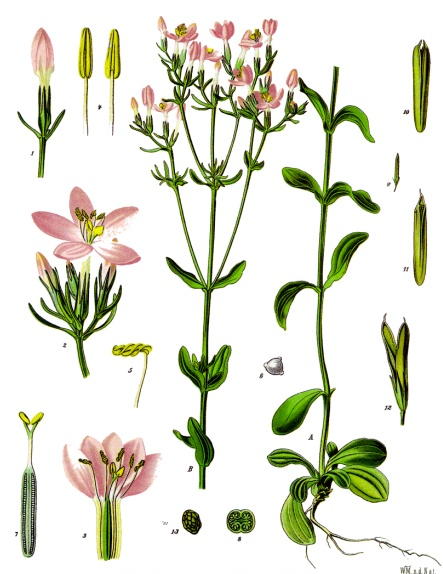
Erythraea centaurium (L)
Synonyms: Centaurium erythraea
(Rafin.), feverwort, European centaury, bitterherb, centaury gentian, common centaury,
lesser centaury, red centaury, filwort, centory, Christ's ladder
centaury, filwort, centory, Christ's ladder
Order: Gentianaceae
Description: This small, erect annual or biennial herb is indigenous to Europe, Western Asia and North Africa and naturalised in North America. The stem grows up to 30cm high, branching considerably at the top and arising out of a tuft of small, broad ovate leaves. Numerous pink or red flowers arise in a terminal cyme or panicle. It favours dry, shady banks, waysides and pastures. Several subspecies are recognised.
Parts used: flowering aerial parts
Collection: during the flowering period, from June to August
Constituents: Bitter secoiridoid glycosides (gentiopicrin, centapicrin, sweitiamarin, gentioflavoside) alkaloids (gentianine, gentianidine, gentioflavine), Xanthone derivatives, phenolic acids, triterpenes (beta-sitosterol, campesterol, brassicsterol, stigmasterol and others), wax, resin
Actions: Bitter, aromatic, stomachic, tonic, cholagogue, liver stimulant, mild nervine
Indications: Anorexia, dyspepsia
Therapeutics and Pharmacology: Erythraea's bitter action stimulates digestive secretions; the secretion of gastric juice increases as soon as the herb acts on the mucous membranes of the mouth. It also stimulates the sympathetic system and circulation, and has a tonic effect on the blood vessels. Temporary leukocytosis has been noted, implying that the tonic action goes beyond the stomach. In Europe, Erythraea is used in anaemia and liver and gallbladder disease. It is gently laxative and, taken after meals, is an excellent remedy for heartburn. It can also enforce the action of anthelmintic herbs. Like many of the bitter tonics, it is effective in reducing fever and has been used as a quinine substitute in the past. Research has shown that this action is due in part to the phenolic acid component. Another constituent, gentiopicrin, has been reported to have antimalarial properties. Research also confirms the plant's potential for treating rheumatism and gout, as the alkaloid gentianine has demonstrated strongly anti-inflammatory properties.
Combinations: Erythraea may be combined with Filipendula, Chamaemelum and Althaea root in dyspepsia; with Chamaemelum and Arctium root in anorexia nervosa; and with Berberis and Rumex crispus in jaundice.
Preparation and Dosage: (thrice daily)
Regulatory Status: GSL
Dried herb: 2-4g or by infusion
Liquid Extract: 1:1 in 25% alcohol, 2-4ml.
Additional Comments: The mythical centaur Chironia, cured a poison arrow wound with centaury, hence its name. Erythraea is derived from the Greek erythros, meaning red. The Anglo-Saxons used it for snakebite and other poisons, and for curing fevers, hence its common name feverwort. Culpeper described it as 'very wholesome, but not very toothsome'. The German herbalist Father Sebastian Kneipp, recommended centaury for melancholy and for calming the nerves. It was an ingredient of Portland Powder, a treatment for gout. In Egypt the plant is used to treat high blood pressure and kidney stones. It is an ingredient of vermouth and several bitter liqueurs.
Bibliography
BHMA 1983 British Herbal Pharmacopoeia, BHMA, Bournemouth.
Culpeper, N. 1649 Complete Herbal and English Physician, 1990 reprint of the 1814 London edition of Culpeper’s Complete Herbal, Meyer, Illinois.
Grieve, M. 1931 A Modern Herbal, (ed. C.F. Leyel 1985), London.
Hoffmann, D. 1990 The New Holistic Herbal, Second Edition, Element, Shaftesbury.
Lust, J. 1990 The Herb Book, Bantam, London.
Mabey, R. (ed.) 1991 The Complete New Herbal, Penguin, London.
Mills, S.Y. 1993 The A-Z of Modern Herbalism, Diamond Books, London.
Ody, P. 1993 The Herb Society's Complete Medicinal Herbal, Dorling Kindersley, London.
Polunin, M. and Robbins, C. 1992 The Natural Pharmacy, Dorling Kindersley, London.
Weiss, R.F. 1991 Herbal Medicine, Beaconsfield Arcanum, Beaconsfield.
Wren, R.C. 1988 Potter's New Cyclopaedia of Botanical Drugs and Preparations, C.W.Daniel, Saffron Walden.










